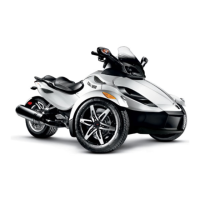REQUIRED RIDING SKILLS AND PRACTICE EXERCISES
– A helper can add an element of sur-
prise to the exercise by deciding
which direction you should swerve,
or if you should come to a stop in-
stead. Have your helper stand at a
safe distance (e.g., beyond the end
of your practice area). As you reach
the first set of cones, the helper can
use hand signals to indicate which
direction to swerve or for you to
stop.
– Practice checkingyourmirrorsand
blind spot before you swerve.
10) Operating in Reverse
Purpose
– Become familiar with the vehicle’s
handling and turning radius in re-
verse.
Directions
Shiftinto reverse. See
SHIFTINGINTO
REVERSE (SM5 MODEL)
..
Check that the area behind you is clear
and continue to look backwards while
youeaseouttheclutch. Becareful
not to strike anything with your front
wheels as you back up. Slow and stop
using clutch and brake, just like when
operating normally.
Back for a few feet at time, stopping in
between.
Keep your speed low and do not back
up for long distances.
After you are comfortable with re-
verse, back into a parking space as
shown in the diagram below.
1
3
2
4
rmo2008-001-048_a
1. Start
2. Reverse
3. Stop
4. Forward
Additional Practice in Controlled
Environments
Onceyouarecomfortablewithallof
the above exercises, you can try a few
other things as space and conditions
allow. This might be in the parking lot
or at a later time in a place where you
have the opportunity without putting
yourself at risk.
– Quick starts: Try quickly getting up
to speed and upshifting through the
gears.
– Quick stop from higher speed:
Similar to the quick stop exercise,
but performed from higher speeds
to get a feel for emergency stops.
– Starting up an incline: To do this,
keep holding the brake pedal as
you
release the clutch lever until you are
in the friction zone. This will keep
you from rolling backwards.
50
_____
SAFE OPE
RATING INSTRUCTIONS
______

